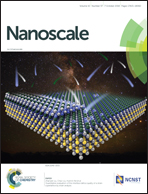Enhanced immunofluorescence detection of a protein marker using a PAA modified ZnO nanorod array-based microfluidic device†
Abstract
Zinc oxide (ZnO) often serves as protein microarray substrates owing to its outstanding fluorescence enhancement effect. However, the integration of functional substrates with microfluidic technology to detect cancer biomarkers still needs to be optimized and promoted, for example, the optimization of micro/nanostructure and hydrophilic modification strategies for fluorescence immunoassays. Here, ZnO nanorod arrays were constructed on the inner wall of glass capillaries through a microfluidic chemical method, and the electrostatic layer by layer self-assembly was applied to modify the nanorod array with hydrophilic polyelectrolyte-polyacrylic acid (PAA). The effects of the flow rate and the reagent concentration on the morphology of the ZnO nanorod array were investigated. The ZnO nanorod array-based glass capillary, prepared at 25 μL min−1 for 4 min with 50 mM Zn2+ in solution, showed a remarkable enhancement in fluorescence performance. In addition, the introduction of PAA suppressed the interference of nonspecific protein and improved the antibody loading capacity effectively. In the detection of carcinoembryonic antigen, the limit of detection reached 100 fg mL−1, which indicated that the ZnO@PAA nanorod array-based microfluidic device exhibits remarkable fluorescence detection performance towards protein markers and possesses potential to be applied to point-of-care diagnostics and high throughput cancer biomarker detection.



 Please wait while we load your content...
Please wait while we load your content...